Reston vs. Tyson's Corner misses the point
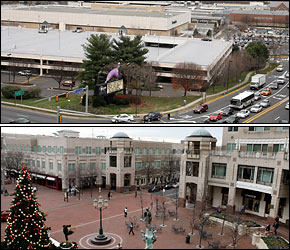 Tysons on top, Reston on bottom. From a loaf of bread, the top piece for the sandwich isn't much different from the bottom piece. (Photo: Jahi Chikwendiu/Washington Post)
Tysons on top, Reston on bottom. From a loaf of bread, the top piece for the sandwich isn't much different from the bottom piece. (Photo: Jahi Chikwendiu/Washington Post)Steve Pearlstein, the Post's business section columnist writes about Reston and Tyson's Corner, saying that the latter is more interesting, more gritty. See "Reston Overtakes Tysons as New 'Hot Property'." Aren't they both equally dull, at least compared to the city, or more importantly to traditional commercial districts?
Looking for good guidance about urban vitality from Steve Pearlstein is a lost cause. He almost gets it when quoting the Reston planner. He writes:
It's just too neat, too homogenized. The stores are all outlets of national chains. There are no churches, no schools, no liquor stores, no bums or graffiti. Reston Town Center lacks what architect and urban planner Alan Ward, who was involved in the center's planning, calls the "messy vitality of older towns and cities that grew over time like natural phenomena."
But how is Tysons fundamentally any different from Reston?
The issue for both places is a single (or at the least, very large scale set of) developer(s) with most buildings all developed at the same time. So you get serial sameness.
I think what people call grit is really a search for authentic variety. People, despite the use of the word grit, aren't looking for graffiti (and in fact, graffiti and trash on the street scare suburbanites as indicators of disorder). In fact, Pearlstein's discussion of graffiti and homeless people in the context of these orgiastic shopping extravaganzas borders on the ludicrous. Suburbanites come to the city to tag buildings, I guess because they feel that suburban places are meaningless canvases for their personal expression.
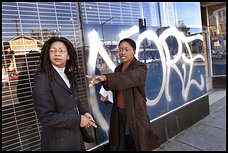 Nores and Koma strike H Street NE. Post photo by Michael Williamson.
Nores and Koma strike H Street NE. Post photo by Michael Williamson.What people call grit is a search for a physical environment that has coherance but is comprised of buildings built at different times in different styles, with businesses that aren't just chains--the same stores they can and do find anywhere and everywhere else, and uses that aren't strictly commercial (libraries, other public buildings such as post offices, govt. offices, churches and other nonprofits), and commercial uses that aren't just retail (some services, entertainment such as movie theaters).
He could have written just as easily about "revitalized" Silver Spring.
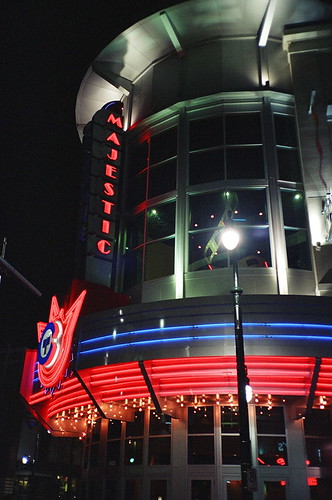 Photo of the Majestic Theater on Ellsworth in Downtown Silver Spring by Scott Law.
Photo of the Majestic Theater on Ellsworth in Downtown Silver Spring by Scott Law.It's grotesque. An outdoor lifestyle mall but it fronts public streets. It's a good job within that context but the buildings were revitalized or built all at the same time and there is a sameness and lack of originality that comes from such development.
But on weekends it's jammed, mostly with young adults, walking and hanging, going to the movies and being public. When your alternative is Wheaton or Montgomery Mall, the chain retail fronted streets of Silver Spring look pretty good.
This area of Silver Spring looks just like the South Side Works in Pittsburgh, which probably looks like Easton Town Center in Columbus Ohio, etc.
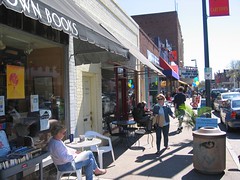 Carytown, Richmond. Photo by Steve Pinkus. Note the Byrd Theater, a major attraction/anchor for the commercial district.
Carytown, Richmond. Photo by Steve Pinkus. Note the Byrd Theater, a major attraction/anchor for the commercial district.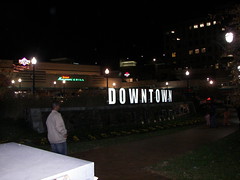 A chain restaurant is in the background in this shot of the "Downtown" sign in Silver Spring.
A chain restaurant is in the background in this shot of the "Downtown" sign in Silver Spring.Bethesda Row pulls it off a bit better because there are a number of independent businesses, albeit mostly restaurants, that complement the chain retail such as Barnes and Noble. See "Why are people so damn good at asking the wrong questions?"
Index Keywords: retail



0 Comments:
Post a Comment
<< Home